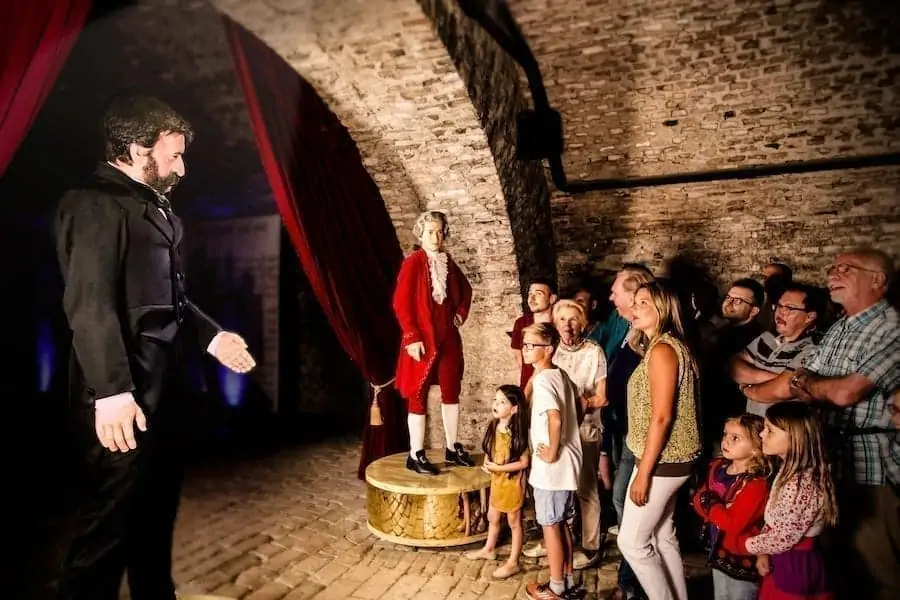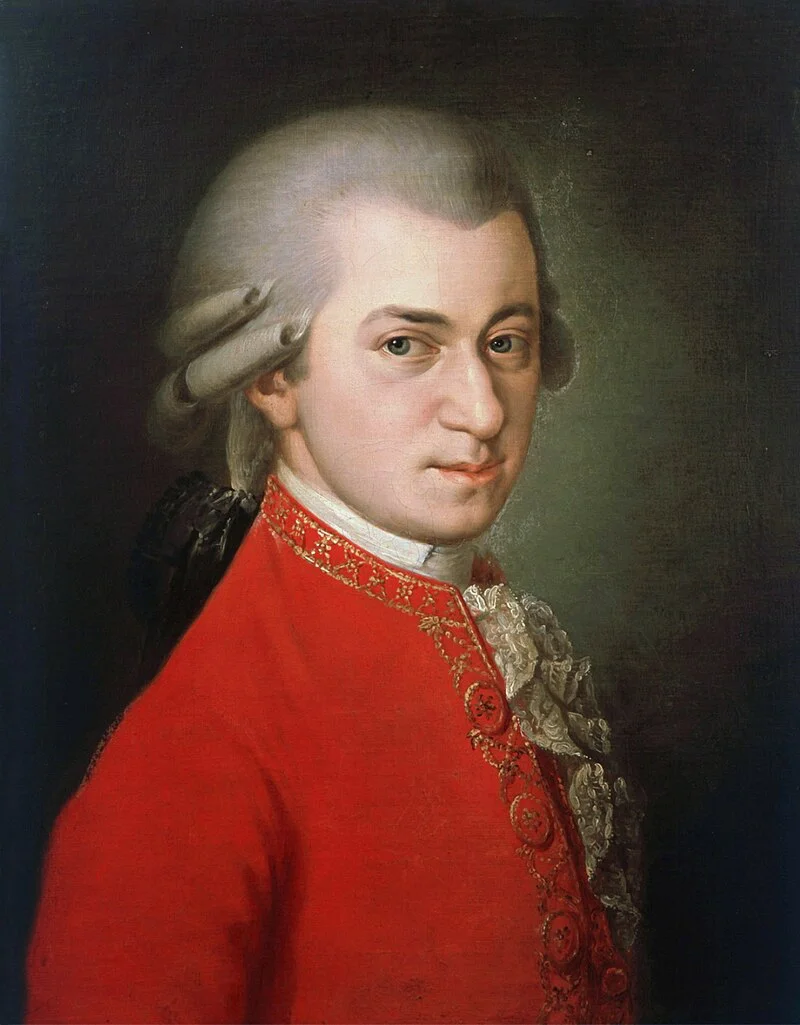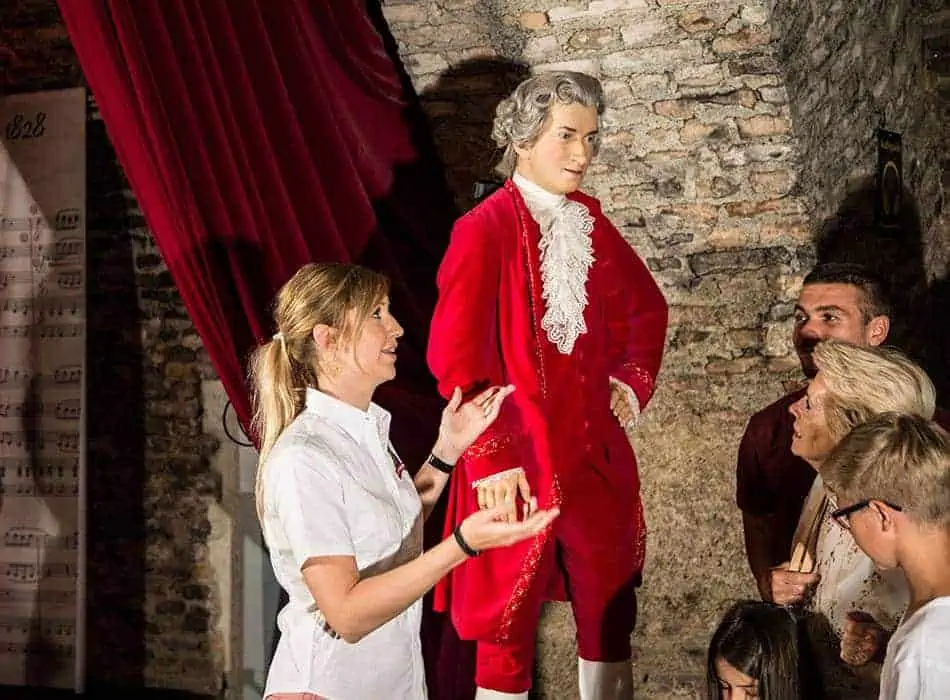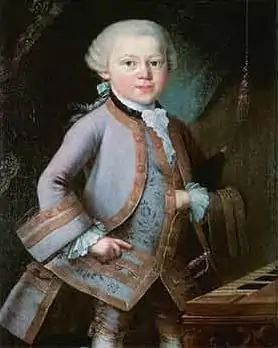Mozart and Strauss
Experience a humorous conversation between the two world-famous composers – Wolfgang Amadeus Mozart – the child prodigy from Salzburg and Johann Strauss Sohn, the real Viennese among the great composers, also known as the “Waltz King”

Look forward to a witty dialog between the two composers Mozart & Strauss, accompanied by their best musical delicacies. Mozart is famous for his works – Die kleine Nachtmusik and The Magic Flute. Johann Strauss Sohn has gone down in history as the composer of the Danube Waltz.

Who was Mozart?
Wolfgang Amadeus Mozart was born on January 27, 1756 in Salzburg’s famous Getreidegasse. He was the youngest child of Leopold Mozart and Anna Maria (née Pertl). As a child he was often called Wolferl, as an adult he liked to call himself “Amadé ” in the French-Viennese way.
His ambitious father taught him together with his older sister Maria Anna, known as Nannerl. Even at a young age, he appeared as a “child prodigy” on concert tours throughout Europe. His first appearance in Vienna was in 1762 when, at the age of six, he performed together with his sister in the Hall of Mirrors in Schönbrunn before the Habsburg ruler Maria-Theresia. Afterwards, he jumped on her lap and “kissed her goodbye”.
/*! elementor – v3.19.0 – 29-01-2024 */
.elementor-column .elementor-spacer-inner{height:var(–spacer-size)}.e-con{–container-widget-width:100%}.e-con-inner>.elementor-widget-spacer,.e-con>.elementor-widget-spacer{width:var(–container-widget-width,var(–spacer-size));–align-self:var(–container-widget-align-self,initial);–flex-shrink:0}.e-con-inner>.elementor-widget-spacer>.elementor-widget-container,.e-con>.elementor-widget-spacer>.elementor-widget-container{height:100%;width:100%}.e-con-inner>.elementor-widget-spacer>.elementor-widget-container>.elementor-spacer,.e-con>.elementor-widget-spacer>.elementor-widget-container>.elementor-spacer{height:100%}.e-con-inner>.elementor-widget-spacer>.elementor-widget-container>.elementor-spacer>.elementor-spacer-inner,.e-con>.elementor-widget-spacer>.elementor-widget-container>.elementor-spacer>.elementor-spacer-inner{height:var(–container-widget-height,var(–spacer-size))}.e-con-inner>.elementor-widget-spacer.elementor-widget-empty,.e-con>.elementor-widget-spacer.elementor-widget-empty{position:relative;min-height:22px;min-width:22px}.e-con-inner>.elementor-widget-spacer.elementor-widget-empty .elementor-widget-empty-icon,.e-con>.elementor-widget-spacer.elementor-widget-empty .elementor-widget-empty-icon{position:absolute;top:0;bottom:0;left:0;right:0;margin:auto;padding:0;width:22px;height:22px}
Mozart’s life

This was followed by numerous trips throughout Europe. His first stops were Germany, France and Great Britain. Later, there were longer trips to Italy and he repeatedly returned to Salzburg, where he was concertmaster of the court chapel in the service of Prince Archbishop Hieronymus Count Colloredo.
Over time, tensions in the archbishop’s office grew. The break finally came with the famous “kick”, which was given to him by the count’s emissary, Count Arco, at the Deutschordenshaus in Vienna. In other words, he was kicked into independence.
He began his career as a freelance artist in Vienna in 1781, giving piano lessons, playing in concerts and composing for a wide variety of clients. Together with Haydn and Beethoven , he founded Viennese Classicism.
Mozart’s musical competition with the court composer Antonio Salieri has also gone down in history. Emperor Joseph II set both of them the task of writing a short opera and performing it on two opposite stages in the Orangery at Schönbrunn . The difference in rank was noticeable – Mozart’s opera was performed as a prelude and Salieri’s piece lasted twice as long and was a huge success. This was also reflected in the fee, as Salieri received double the salary.
Mozart and Constanze Weber
Mozart married Constanze Weber in Vienna’s St. Stephen’s Cathedral and spent happy years with her in the Mozarthaus in Domgasse, which is still preserved today. They had six children, of whom only two sons survived. His most famous works were composed here, such as “Le Nozze di Figaro”, “Don Giovanni” and“Eine kleine Nachtmusik”.
Around 1790, Mozart was at the height of his career. This was followed by the works “Cosi fan tutte”, “La Clemenza di Tito” and finally his best-known and probably most famous work, the singspiel “The Magic Flute”.
The last three years of Mozart’s life (1789-91) were also artistically and financially successful. The Magic Flute was a great success, but he was still repeatedly in debt. Together with Emanuel Schikaneder, the theater director of the Freihaustheater auf der Wieden, he was a brother in the Masonic lodge “Zur Wohltätigkeit”.
The Requiem in D minor was his last composition and during this time he fell seriously ill. He died on December 5, 1791 at the age of only 35 from the local Friesian fever. As was customary at the time, he was buried in a shaft grave at St. Marx cemetery . Later, it was only possible to roughly locate the exact burial site. Today we can visit another grave of honor at the Central Cemetery and admire the statue of Mozart in the Burggarten .


Johann Strauss son
Johann Strauss Sohn, the Waltz King, was born in Vienna on October 25, 1825 and also died in Vienna in 1899. He was a composer, conductor, son of Johann Strauss’ father and brother of Josef and Eduard. Even as a child, he harbored the desire to become a musician, which his father rather disliked.
His father was also a musician and court ballmaster to the emperor, but left the family for another woman. His mother Anna now supported her son all the more in becoming a successful composer.
Johann Strauss’ son made a very successful debut at the age of 19 with his band at Dommayer’s Casino in Hietzing and thus became his father’s greatest rival. He became even more successful than his father. His concert tours through Europe and the USA led to a veritable “Strauss mania”.
His early years were characterized by competition with his father. As his father recruited his audience from the middle and upper classes, his son initially turned to students, ethnic minorities and marginalized groups. He also sought engagements outside Vienna, which led to numerous concert tours throughout Europe.


After his father died suddenly of scarlet fever in 1849 at the age of just 45, his son was able to take over his father’s orchestra. It was not until 1852 that Johann Strauss son was entrusted with the performance of music at the imperial court. This was later followed by the title of k.k.Hofballmusik-Direktor.
The operetta “Fledermaus” and the “Gypsy Baron” created further hype. He was showered with invitations and honors as the Waltz King. During the day he composed countless waltzes and operettas and in the evening he played late into the night. He became famous worldwide for the Danube Waltz, which is regarded as Austria’s secret anthem.
Strauss’ enormous workload took its toll: physical breakdowns necessitated a series of spa stays in the years 1853 – 55. He found inspiration in Badgastein and then spent several seasons as a guest in Pavlovsk near St. Petersburg, where he was also able to win over the Russian Tsar’s family. It was the performances in Pavlovsk that allowed Strauss’s son to finally step out of his father’s shadow in Vienna.
In 1862, he married the former singer Henriette, called Jetty, who was seven years his senior and who also became his manager. After she died in 1878, he married the actress and singer Ernestine Dittrich, known as Lili , who was 25 years his junior . However, they soon divorced because of another man.

He consoled himself with Adele Strauss, 31 years his junior. In order to marry her, he converted from Catholicism to Protestantism and even left the Austrian state and became a citizen of Saxe-Coburg and Gotha.
In 1872 , he embarked on his longest concert tour, which took him across the Atlantic to the “World Peace Festival” in Boston and on to New York . However, he soon suffered from homesickness and was glad to be able to perform in Vienna again.
He died on June 3, 1899 at the age of 74 as a result of pneumonia. He was married three times and left no children.
His monument in the Stadtpark is one of the most photographed in Vienna and we can visit his grave of honor at the Central Cemetery. His former home on Praterstrasse, where he composed the famous Danube Waltz, can also be visited. There is also an interesting museum about the Strauss dynasty in the 9th district.

VR Music Ride
